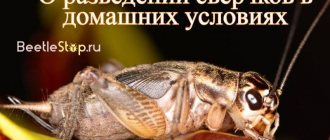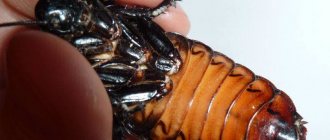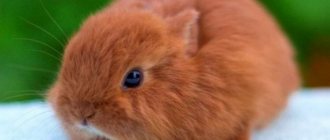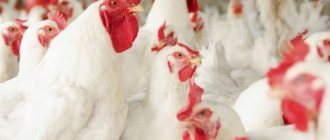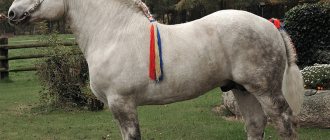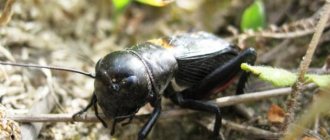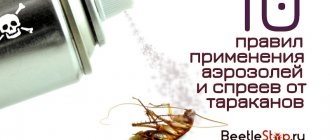Growing insects as a business, report from the farm
In Asia, insects have long been eaten. This is not news, but still unusual for a European. When Russian tourists come to China or Thailand and see spots with fried insects on the market, the typical reaction is to take a photo or quickly move away. The bravest ones try it mainly for the sake of an unusual photograph for social networks. But since the locals eat them, it means they are grown somewhere. IQ Review visited a farm where crickets and butterfly pupae are raised for sale. Our report today is about the insect business.
This insect farm is located in Thailand in the Pattaya suburb of Huai Yai. It supplies products to local markets, where Thais and tourists from all over the world buy them.
Apparently, the beetle business is going well - land here is expensive. Of course, this is not the first line from the sea, but only 5 km. For comparison, a good home in this area costs $120,000. The owners' house is simple, combined with a farm. However, they have another piece of land at some distance, intended for breeding insects.
Mostly crickets are grown here for food. They are the ones rummaging around in the box in the photo. Here's the view from above.
Egg cells are used specifically. Insects gnaw holes in them and lay eggs, which fall to the next layer - this makes it easier to separate generations. They are fed pumpkin.
Here's a short video of what the farm looks like from the inside.
When the insects lay eggs, the larvae are separated directly from the cells and transplanted into separate boxes.
Insects grow quickly, a lot of them grow. This photo shows only a small part of what falls out of the cells when you shake them.
You may ask why insects don't try to escape from open boxes. Well, they don’t know that their original box is part of the business of growing them for food! They feel at home. All the conditions - warmth, as much light as needed and food - what more could a cricket want?
This video is not for the faint of heart. The box has been shaken a little, and the beetle catch is being prepared for sale.
Here is a bucket full of insects.
Next, the live goods are packaged and weighed. Here's how it happens.
The bugs scurry around in the bag... not for long. Like any living beings, without oxygen they suffocate. But it's for their own good. It's much better than dying in boiling oil.
In addition to crickets, butterfly pupae are sold here. They look like healthy larvae. We were not allowed to see the growing process. The goods were sold already dead.
SUMMARY
Raising insects costs next to nothing. Once you invest money in space and mesh boxes, you spend only on electricity and vegetables. The same customer base buys regularly. The product remains fresh for 2-3 days. There are several points selling insects in Pattaya. There are no millions here, but the demand is stable.
Additionally, you can raise chickens. It is not profitable to buy insects to feed poultry and livestock. A kilo of beetles costs $3, and a kilo of rice costs less than $1. But for homestead farming it is quite suitable. Visually, the owners of this business live well: they have iPhones and an indispensable attribute of the Thai middle class - a new pickup truck. Even 2 pickups.
We went to the farm with the owner of a small shop selling fried insects. After the purchase we were given a business card - come again!
Ananya bought a nearby market stall with bugs. The family business of the previous owners was going well, but not well enough to support all five family members. As a result, they quarreled and decided to sell their point.
About 3 kg of insects are sold per day - fried crickets and butterfly pupae. Their purchase price is $10. A plate of approximately 80 grams costs $0.6. The only expenses for cooking are oil, sauce and gas for frying. The outlet sells not only fried beetles, so it is not possible to calculate exact figures on profit and profitability.
The larvae are rich in protein. They taste like seeds. Bon appetit!
Feeding the crickets
In the wild, the cricket feeds on pieces of plants, small insects, and dead arthropods. Some individuals do not disdain cannibalism and destruction of the clutches of their relatives. But what to feed crickets at home?
When kept in captivity, the following is suitable food for crickets:
- finely chopped vegetables and fruits;
- greens, tops, burdock and dandelion leaves;
- milk in powder form, including infant formula;
- oatmeal and bran;
- food for cats and dogs;
- boiled chicken egg;
- boiled lean meat.
How to water crickets? Some experts suggest installing a drinking bowl, but this is not entirely safe: young individuals drown in them, females lay eggs, and it’s quite easy to turn it over. Another option - spraying one corner with a spray bottle - entails a persistent increase in humidity, and, as a result, the appearance of mites. Therefore, to save yourself from problems, you just need to give enough juicy and wet food, forgetting about drinking bowls and spraying. But we should not forget: lack of moisture will lead to death or cannibalism.
How to get rid of field cricket?
To avoid the appearance of field crickets, the soil needs to be dug up in spring and autumn. This will help eliminate insect larvae. It is also important to carry out regular cleaning of the site, removing construction and household waste, since crickets can use it as shelter for the winter.
If necessary, you can use insecticides, among which the most popular are:
- "Karbofos";
- "Nemabakt";
- "Antonem-F".
It is recommended to give preference to biological preparations, since they do not harm plants and do not pose a threat to people or pets. The disadvantages of such products are usually high cost or slightly lower effectiveness.
Please note that the field cricket is on the verge of extinction in some places, so it is not recommended to destroy it, as this can lead to the complete loss of the insect species, in addition, in some cities this may be prohibited by law.
Cricket lifestyle
Crickets belong to the suborder Longwhiskers, order Orthoptera and number more than 2000 species. They are able to adapt well to environmental conditions, feeling comfortable both in the hot, humid tropics and in practically barren, dry areas.
The house cricket, Acheta domestica, lives naturally in the desert areas of North Africa, where water is available only in the form of dew drops and there is virtually no vegetation. What do crickets eat in the wild? In such modest conditions, the desert inhabitant does not disdain anything; he feeds on the organic remains found, even those that have long dried up.
Persistently digging in the sand, it looks for eggs, larvae and pupae of other insects. At home, in dark basement corners or under the floor of a hut, the cricket behaves the same way and actively destroys flea nests and cockroach broods. What do crickets eat at home?
Legends and beliefs about crickets
So, the cricket family belongs to the order Orthoptera, and in nature there are about 2,300 species. These insects consider a moderate humid climate to be a favorable habitat, and their historical homeland is the island of Madagascar and India. However, today these night “singers” are widespread throughout the world; moreover, numerous legends and beliefs are often associated with them.
Many crickets fly into the house and settle in secluded places, and some species are considered exotic and turn into real human pets. This is not surprising, because there is an opinion that such insects appear only in those homes where there is a feeling of kindness, comfort and coziness. So this is a positive symbol for the future, and you should not kick the cricket out of your abode.
The domestic cricket gets along well in the same territory with humans, does not cause any difficulties and, moreover, does not harm in its own habitat. He only sings, and there is no doubt that he is the strongest male of all competitors. Females prefer to remain silent in the presence of the leader, and weak males are simply expelled from the home. So it’s the same melody, which very soon becomes familiar and even positive.
Description and area of residence
The true cricket is a typical representative of the family of Orthoptera jumping insects. Its close relatives are grasshoppers and locusts. The insect has an elongated body, a large head, and a gnawing type mouthparts. The antennae are long, thread-like, and vision is well developed. The hind legs with thickened thighs allow them to push off when jumping.
The elytra are dense, leathery, the wings are fan-shaped with veins. Females have an ovipositor, which they use to cut through stems to lay eggs. Few people know what a cricket looks like, but they have heard its chirping at dusk. It creates its trills by rubbing the elytra. The faster the vibration, the higher the sound. The special structure of the elytra makes it possible to produce sounds in a wide range.
The insects are widespread in Asia, Europe, North Africa and America. In Australia they are found only in Adelaide, where they were introduced from other countries. They find cracks for housing, dig holes or hide under stones. Activity falls in the summer months, because at temperatures below +21 0 insects become lethargic and stop feeding. The love of warmth forced crickets to seek refuge in human habitation. With the onset of autumn, they move into houses, heated warehouses and industrial buildings.
Habitat and lifestyle
House crickets live where there is human habitation. They prefer places with high humidity and natural shelter. The life of a cricket directly depends on temperature:
- at +30 ℃ they are active, hunt, chirp, and are able to reproduce;
- below +20 ℃ life processes slow down, mobility decreases;
- Around 0℃, crickets hibernate.
The male defends his territory from invasions, engaging in fierce battles with rivals.
Interesting fact! In a fight with an opponent, the cricket often loses its elytra (one or both). Having lost the ability to make sounds and attract a female, the male loses the ability to reproduce.
How often to clean the cricket container
To prevent bacteria and germs from multiplying in the container, it is recommended to clean your pet’s house at least 1-2 times a week. During this time, he should be placed in a temporary house. But if you notice that its abdomen is swollen, and an unpleasant odor emanates from the container itself, you should not limit yourself to cleaning alone. Your pet could become infected with microsporidia and you will need to disinfect its home.
Unsanitary conditions for keeping crickets encourage the development of mites, and this can lead to the death of your unusual creature. Therefore, do not ignore cleaning, and if you have already got a cricket, keep it not only comfortable, but also clean.
Financial part
The project for growing crickets is also interesting in the sense that it is quite profitable and simple. A beginner will not have to invest large sums of money to set up a farm. The purchase of equipment is not required, and 1-2 people are sufficient. The cost of the product is very low and fluctuates around $2 per 1 kg of weight.
The profitability of the project is considered high, since even at the lowest prices, you can receive up to 100 thousand dollars per year from a small farm. And the purchase of inventory, containers and other unforeseen expenses will cost no more than 25,000. That is, already from the first batches of sold products in any form, you can return the investment.
Video: how to breed and keep crickets?
Insect nutrition
In their natural environment, crickets feed on fresh grass shoots and bush leaves. Having settled on the site and significantly increased the population, they will begin to harm garden crops. Adults prefer to nibble on seedlings rather than weeds. Their diet is not limited to plant foods; insects require protein for development. Its source is small insects, corpses or their own offspring.
What does a cricket eat when it finds itself at home? In this case, he shows omnivorousness, eating crumbs of bread, droplets of liquid dishes and drinks, pieces of vegetables and fruits with equal pleasure. Meat or fish that falls on the floor will also be eaten by the little neighbors. Showing the instincts of a hunter, they can catch flies or small invertebrates that end up in the house.
Many seemingly harmless insects turn out to be a source of danger, so the question often arises: do crickets bite? You can rest assured about night singers, they don’t bite people. The jaws of the gnawing type are not adapted for attacking large objects; moreover, aggressiveness is shown only towards males in foreign territory.
Nutritional Features
Today, modern man has been able to tame even such a small insect as a cricket. The purpose of his breeding was melodic tunes, which he produces with particular regularity. In order to raise a full-fledged individual at home and count on offspring, you need to know the rules of nutrition and tirelessly follow the recommendations below.
So, crickets are omnivores, so it is quite acceptable to experiment with the menu, adding or removing new dishes each time. Leftover fruit is considered a favorite delicacy, and you can give food that is not the freshest. Crickets will definitely be grateful for such vitamins, especially since they are not particularly selective in their food consumption.
In addition, you can pamper the insect with oatmeal and crackers, which they will happily eat. Any crumbs will be welcome, and the cricket doesn’t need much to feel full and start singing its catchy trill again. The diet may also contain coarse fiber in the form of a bunch of dry grass to normalize intestinal function. So it is important to observe all these subtleties and not deviate from the diet suggested above.
If you decide to grow crickets at home, you can use an old aquarium as a house, with an even layer of soil and substrate placed on the bottom. The presence of branches and dry grass is also necessary, otherwise the trill of the insect will not be heard.
Soft caterpillars and pupae can also make up the cricket's daily menu, but it is advisable to offer such ingredients in strictly limited quantities for the normal functionality of the digestive system. Insects also love leaves of all plants, dandelions, unripe grass seeds and clover leaves.
If it is crickets that are bred at home, then the adults feed well from the feeder, while it is advisable for the young to distribute the food over the entire surface of the soil. Over time and as the individuals grow older, the need for this disappears, but at first it is important to control so that the inexperienced insect does not starve.
Nowadays, special plant-based foods predominate on the market, providing a full range of minerals, vitamins and microelements. The presence of protein as the main organic compound is very important, since a deficiency of this element leads to the non-viability of laid eggs. Moreover, the female quickly eats them, so it is best to use boiled chicken protein in the diet.
Many crickets, accustomed to living at home, eat synthetic food from fish, dogs and cats, and such an unusual diet in no way affects their viability or reproductive function. Milk can be offered as a drink, but this is at the choice of the breeder himself.
Reproduction
Reproduction of crickets occurs when the insects create comfortable conditions and an abundance of food. In a population, there must be at least 4 females per 1 male, otherwise deadly struggles and deafening crackling are guaranteed. A small container (4 cm deep) is placed in the container, into which wet peat, sand or plain soil is placed. Soon the females will lay their eggs here. To avoid destruction of the clutch by males, this container should be covered with a fine mesh or strainer. Soon the larvae will appear, which after a few molts will become adults.
Raising crickets at home is a fairly simple task. The main thing is to create suitable conditions - temperature, humidity and refreshment, and then give your pets the required amount of food: dry and wet. Females are quite undemanding to conditions, so very soon the population will begin to rapidly increase.
Conditions
Unlike other species, two-spotted crickets need relatively low air temperatures - about 23 degrees. The higher the temperature, the faster the crickets will grow and reproduce. However, food consumption in this case will increase.
The humidity in the terrarium should be about 50%. Cricket eggs must be kept in moist soil, otherwise they will dry out. However, high humidity in a common container can lead to the death of the colony.
Relationships with a person
Cricket
A very difficult topic for cricket. In Japan, it was customary to keep these insects at home in miniature cages. In Asia they are specially bred for food; in North America they are used as bait. In Russia today, many exotic animal lovers keep reptiles that eat crickets. Owners of these cold-blooded animals, along with reptiles, usually breed crickets as food for their pets.
If a cricket suddenly appears in a multi-storey building in the city center, you can be sure that it has escaped from a pet reptile lover. Much less often such escapes occur from insect lovers due to the fact that they also prefer to keep exotic crickets.
Cricket in the house
If a “baked musician” appeared in the house, it was considered a good omen, a sign of prosperity, a talisman against poverty and crop failure. It was impossible to kill the insect; on the contrary, it was necessary to feed it and appease it.
In China and Japan, they even built separate houses for them and hung them in the middle of the house so that they could enjoy their singing.
However, although the trill of a cricket in the house is a favorable omen, people are increasingly trying to get rid of the house musician by all means.
Types of crickets and creating the necessary conditions for them
The success of cricket breeding depends on how successfully the conditions were created and the maintenance was organized. Insects must receive enough nutrition and be in an environment close to their natural habitat. In this case, you can expect the crickets to lead an active lifestyle and increase their population. If the conditions are unsuitable, then pets can even kill each other.
Ideally suited for home maintenance:
- House crickets are the most common species in captivity. They are small in size and are most often bred for food. With the onset of evening and until morning they can emit ringing trills.
- Banana. The species is characterized by a high reproduction rate and love of warmth.
- Two-spotted. A dry microclimate and relatively low air temperature suit them: 23° C will be quite enough for insects.
The two-spotted cricket is larger than the house cricket: its body can reach 3 cm
Keeping crickets involves paying attention to the characteristics of each species. But there are also general recommendations that are universal in any situation.
Container
The first step is to take care of the container for growing crickets. Any container made of plastic, glass or chipboard can serve as an insectarium. The main thing is that its area is at least 60x40 cm, and its height is more than 30 cm. In such a space, insects will feel comfortable.
People who know first-hand how to breed crickets at home advise placing boxes with cells intended for eggs on top of each other in the cage. This trick increases the useful area, and the number of pets will increase. In addition, the cells remind crickets of burrows - shelters that they dig in life in the wild. For young individuals that have recently been born, crumpled paper is suitable. Dry fish food mixed with oatmeal, peat, sand, and bran is suitable as a primer. But you don’t have to pour it in.
To illuminate the container, incandescent lamps with a power of 25 to 40 W are used. They will not only create light, but also be a source of heat. A 16-hour daylight period is sufficient for crickets to thrive.
Microclimate
The microclimate suitable for crickets consists of two important indicators:
The optimal temperature depends on the species. For example, the heat-loving banana cricket does well when it is above 26°C, although it would prefer a reading between 28°C and 37°C. For house and two-spotted crickets, a temperature of 23 °C is suitable. The higher the air temperature, the better the health of chirping pets and the more intensive their growth. But at the same time they need more food and more frequent bedding changes. Air humidity should be at least 40–50%
This value is especially important for cricket eggs, which can simply die in dry soil. Therefore, the substrate with masonry must be constantly moistened
If the humidity is too high, then mites will appear in the insectarium, and this will mean the possible death of the crickets.
Once suitable conditions have been created, the first residents can be allowed into the container.
The benefits and harms of field cricket for humans
The field cricket is considered a pest. It is unpretentious to food, so it can feed on almost any garden plants, and especially loves seedlings. This leads to a slowdown or complete stop of growth and a decrease in plant productivity.
But you need to pay attention to the fact that the insect also brings benefits. It hunts other pests, helping to reduce their numbers in the area.
It is important to consider that due to the loss of natural habitat, the population of field crickets has begun to decline. Therefore, the species is in the Red Book in some countries. In Russia, for example, the insect is on the verge of extinction in the Tula region.
Breeding crickets May 22, 2012 12:58 #325
| Does anyone have experience in raising crickets at home? Help me please. :Save: Answer a few questions. There is a container measuring 60x40x40 cm, is this enough? (I used oatmeal as a soil, covering an egg carton) How many crickets are needed for stable growth of the colony? In the corner of the container, I placed a small cage: 20x10x6 cm for laying larvae, filled it with quartz sand. How to determine which of them are females and which are males? )) At what period do they begin to sing and courtship? Do they need any special temperature regime for this? In general, I will be glad to listen to any advice and nuances on this topic. |
| Do you need a miracle? Do it yourself! Our diary The administrator forbade posting entries to guests. |
What does the house cricket (house cricket) eat?
Under natural conditions, the basis of the menu of house crickets is any plant food. However, insects require protein supplements in their diet. They satisfy this need by attacking small invertebrates, eating dead insects of other species, or even attacking their own kind. Quite often, young individuals of crickets become an additional dish for an adult relative, and eating egg clutches is common.
Once in human homes, crickets gain access to a limitless source of food. House crickets enjoy eating pieces of vegetables, fruits or bread crumbs left after breakfast, lunch or dinner. If a cockroach or other small insect gets in the way of a house cricket, it will certainly become part of its diet. No less attractive to crickets are droplets of any drinks consumed by humans, with the exception, of course, of alcohol.
References:
- Gorokhov, A.V. Life forms of crickets (Orthoptera, Grylloidea) of Central Asia / Gorokhov A.V. // Entomol. review – 1979.- T.58, No. 3.- P.506-521.
- Gorokhov, A.V. On the morphological criteria of the genus in crickets (Orthoptera, Grylloidea) / Gorokhov A.V. // General entomol. – L.: Science – 1986. – T. 68. – P. 17-19.
- Zhantiev, R.D. Bioacoustics of insects / R.D. Zhantiev. – M.: Publishing house Mosk. University, 1981. – 256 p.
- Zhuravlev, Yu.D. Insect cultures used for feeding amphibians and reptiles in the terrarium of the Almaty Zoo / Zhuravlev Yu.D., Pugacheva N.A. // Scientific research in zoological parks. – M., 1994. – Issue. 4. – pp. 110-111.
- Knyazev, A.N. Developmental cycle of the cricket Gryllus bimaculatus Deg. (Orthoptera, Gryllidae) under laboratory conditions / Knyazev A.N. // Entomol. review – 1985. –T.64, Issue 1. – P. 58-74.
- Yasyukevich, V.V. Cultivation of crickets for feeding exotic animals / Yasyukevich V.V., Rivkin L.E. .// Scientific materials - practical conf. Animal culture and biological resources. – M.: Scientific T. ed. KMK., 2005. – pp. 146-148.
- Alexander RD The evolution of genitalia and mating behavior in crickets (Gryllidae) and other Orthoptera / Alexander RD, Otte D. // Misc. Pabl. Mus. Zool. Univ. Michigan. – 1967. – Vol. 133. – R. 1-62.
- McFarlane JE Studies on group effects in crickets / McFarlane JE // Can. J Zool. – 1984. – Vol. 44. – P. 1017-1021.
- Wineriter SA Group and individual rearing of field crickets (Orthoptera: Gryllidae) / Wineriter SA, Walker TJ // Entomol. News. – 1988. –Vol. 99, No. 1. – P. 53-62.
- Wyniger R. Insektenzucht / R. Wyniger. – Stuttgart: E. Ulmer Verlag, 1974. – 368 rub.
Cricket Reproduction
Crickets have polygamous relationships, each male is the owner of a certain territory, which is inhabited by several females who are part of a kind of harem of this male. If another male encroaches on the territory of this male, fierce fights occur between them.
An obligatory attribute of the mating games of these insects is the famous trills of crickets, performing their musical serenades, the male attracts the female for mating.
Crickets breed throughout the year, but their peak sexual activity occurs in the summer. A fertilized female cricket prepares holes in the ground where she lays her eggs, somewhat similar to bananas. During one oviposition, a female cricket can lay from 40 to 179 eggs.
After one to two months (depending on the temperature and the environment in general), larvae begin to emerge from the eggs. The larva in its appearance resembles an adult cricket, but in order to become one, it will have to go through 10 molts, occurring over 7 weeks, during which the body undergoes restructuring. After the last molt, the larva produces a normal, mature cricket.
Appearance of a cricket
Crickets are extremely cunning and agile creatures. It is very difficult to see them, since they move very quickly, and even more so to catch them. However, if you very quietly approach the place where the “trills” are coming from, in principle, you can see it. If you're lucky. The average body length of an adult cricket is 2 cm, but there are also individuals up to 2.5 cm long. The body color of these insects can vary: from straw-fawn with brown stripes to yellowish with mottled or dull brown spots (or specks).
Since crickets are orthoptera insects, their elytra in a calm state have a flat, elongated shape and lie on the back. It is curious that the left one is always covered by the right one. The cricket's head is painted with three dark stripes. The wings of crickets are well developed and are used for constant flights from one place to another. Antennae (cerci) are present in both females and males. Crickets lay eggs, so females have a long ovipositor, the length of which varies from 10 to 15 mm. The eggs are 2.5 mm long. Their shape resembles yellow-white.
Life cycle
Sexual differences in insects are manifested in the presence of a chirping apparatus in males and an ovipositor in females. The dimensions of the appendage are 10-15 mm; with its help, females lay eggs in the ground. The cricket is a type of insect with incomplete metamorphosis. This means that its development takes place in three stages:
- egg;
- larva;
- imago.
Larvae of species with incomplete metamorphosis have much in common with adults. For their appearance, a sufficient amount of moisture and high temperature are required. The female mates several times and lays eggs from 2 to 4 weeks, one at a time or in groups of 2-4 pieces. In total, up to 500 of them are buried. The number of surviving masonry depends on natural factors. Having emerged from the egg, the larva molts for the first time. During subsequent moults, the number of facets in the eyes and the length of the antennae increase, and wing primordia develop. It will take them 1-1.5 months to transform into an adult. How long do crickets live? The life cycle of most species takes only 3 months.
What to feed the larvae
Zophobas larvae: on the left - just molted, still white
Typically, the larvae are fed potatoes, apples or carrots - this is cheap and always available, and this food also provides the larvae with the necessary water. It is also common to keep them on bran or oatmeal - these products serve not only as food, but also as a substrate, in which the larvae can burrow and feel safe. Just in case, we note that for other animals (cockroaches, crickets, etc.) this method should absolutely not be used; darkling beetle larvae are the only ones that can be kept on the food substrate. Both larvae and adult beetles can consume protein sources such as dog or cat food and even dead fish, leaving behind only tough skin and bones. Does not cope well with pure fats or very fatty foods such as avocados.
What are they eating?
Their diet is varied. But mainly it consists of the food described below.
Dead insects. If they find dead insects, they will eat them. The less intense the prey hunt, the better for crickets.
Mushrooms. Since they spend a lot of time around wooden piles and in damp conditions, they encounter fungi. Why not eat them, because they are motionless and you don’t need to waste energy on hunting?
Plants. Leaves, stems and seeds are good food for these insects.
Fruits. This applies to fruit that has fallen from a tree or is in your home. If they have access to something sweet and soft, then they will like it.
Cloth. Yes, they even eat clothes. If you leave it on the floor in your home or outside for a certain period of time, you may notice the damage caused. They don't care when they're hungry. They will eat silk and even wool.
Other crickets. If there is no food around, they will begin to hunt for cannibalism.
Paper. They eat paper products. Naturally, if there is nothing tastier nearby.
Leather. They also eat leather products. They will chew on leather sofas, wallets, bags, etc. Therefore, if such “guests” appear in your house, it is better to hide any leather items.
Farm at home
There is also the opposite side of the coin. Fishermen and reptile lovers are often forced to independently breed these insects at home in terrariums. Not every reptile agrees to eat frozen dead food, and the cost of such food in a pet store can ruin lovers of rare animals.
The optimal combination of insects is 1 male to 5 females. When there is an overabundance of males, fierce fights arise between them, which leads to injuries among the breeders. A male that has lost its elytra is unable to produce mating trills and becomes unsuitable for breeding.
Females are provided with a moist substrate for laying eggs. Containers with the substrate are covered with a mesh with a mesh size of 2 mm. The net is needed to prevent insects from digging up and eating the eggs. In favorable home conditions, the female lays 200-500 eggs, shaped like a banana.
The humidity of the substrate must be carefully monitored. When dry, the white eggs dry out and become transparent. This means the death of the masonry. In the case of a dry substrate, the female may try to lay eggs in the drinker. In this case, the masonry will also die.
The house cricket is an insect with an incomplete metamorphosis cycle. There are only three stages in its development:
- egg;
- nymph;
- imago.
The pupal stage is eliminated. The nymph is very similar to the adult, but lacks wings. The nymph has 9-11 stages of development. That is, young domestic crickets will molt 9-11 times.
At home, egg development lasts 10 days, so containers with substrate must be replaced every decade. The fry that emerge from the eggs must be fed with soft protein food, placing the food in a container with low sides. You also need to provide young domestic crickets with water. Wick drinkers are suitable for this.
Depending on the room temperature, the development of house crickets lasts 40-60 days or more. After completing the development cycle, they are suitable for feeding domestic reptiles.
This material tells about what a cricket eats, where it lives and how it can serve humans. Perhaps it will help those who decide to keep these insects at home in an insectarium.
Breeding crickets at home from your own experience.
Probably every owner of an insectivorous animal sooner or later thinks about obtaining food at home. For the first time, faced with the fact that sometimes live food was simply not available, we tried to start breeding crickets ourselves. In practice, this turned out to be not as simple as they say in books and on forums, but through trial and error you can achieve good results. The main thing is desire and patience. Knowing how to properly keep and care for crickets, breeding will not be difficult over time. To do this, you need to place a small container 4-5 cm deep filled with a soft, moist substrate in a cage with adult crickets: vermiculite, soil, peat, sand - everything can be mixed in any proportions or separately, females can lay eggs anywhere, even in wet food ). It is advisable to cover the container with a fine mesh net to prevent adult insects from eating their larvae. If you are not striving for an industrial scale, then let them eat, they won’t eat everything, and the nutritional benefit from this for the crickets themselves will be considerable. There should be more females than males (for 3-4 females there is 1 male), otherwise the latter will not melodiously “sing” to attract the female, but will fight or loudly “drive away” other male competitors.
male imago: female imago:
Adults live for about 2-4 weeks. All this time, the males sing, and the females intensively (in portions of 2-5 pieces) lay eggs in the substrate; one clutch ranges from 350 to 900 eggs, depending on the type of cricket. After one to two weeks, depending on the temperature (the higher, the faster), the babies will hatch, the so-called “cricket dust” measuring 1-2mm. Over the course of two to three months, they will grow and molt periodically until they reach sexual maturity. Also, the entire life cycle of a cricket depends on temperature - the warmer it is, the faster its growth and development. If you do not want the dust to hatch in the same cage, remove the container with the eggs to another warm place with the proper conditions described above. This way you can avoid larger crickets from eating smaller ones and keep the crickets relative to their size. It is advisable to have at least three cages. Remember about the life cycle of crickets and try to make sure that a new generation always grows in time to replace the old generation, then you will never have any shortages of food.
You can ask for information of interest and discuss the article at the following link: Forum about geckos
Features of keeping crickets
Container
If you decide to have such an original and noisy pet in your home (crickets make characteristic sounds, so immediately ask yourself if you are ready for this), make sure to purchase a fairly spacious container. Its size will depend on the number of pets and how comfortable conditions you are going to create for them. You can keep a whole thousand crickets in a container 450 by 425 and 500 centimeters, or even several. The difference will be in the level of comfort.
If the walls of the container are high, you don’t have to cover it, however, in order to avoid all sorts of troubles associated with finding a cricket under the bed or in the bathroom, it is better to take care of a special mesh lid.
The walls of the container must be smooth - it can be glass or plastic. This is necessary in order to prevent the pet from escaping vertically. Do not forget that crickets move very well and quickly on flat vertical surfaces.
If you are going to keep a cricket in a wooden box, then it is better to cover its inside walls with thin glass so that it is not so easy for the cricket to climb up them.
House
Even if you have taken care of a spacious container, do not forget about a special house. You can use egg cartons for this. Place it vertically with small pieces of cardboard between the sides. This will prevent the egg combs from sticking together and there will be good ventilation in the house. Crickets love to hide in such houses.
Substrate selection
At the bottom of the container you will need to pour... not substrate, but dry food. It could be oatmeal, dry baby food, gammarus... Some people add dry food for cats or dogs. True, there is a lot of debate regarding the usefulness of the latter, whether it is worth doing this. So, it's up to you to decide. You will need to place a feeder on top of the food layer. Its role can be played by a board or plywood - on it you will put a portion of wet food every day - carrot salad with apple, lettuce, burdocks, dandelions...
By the way, its appearance depends on the cricket’s diet. The more varied its diet, the more beautiful the cricket looks.
